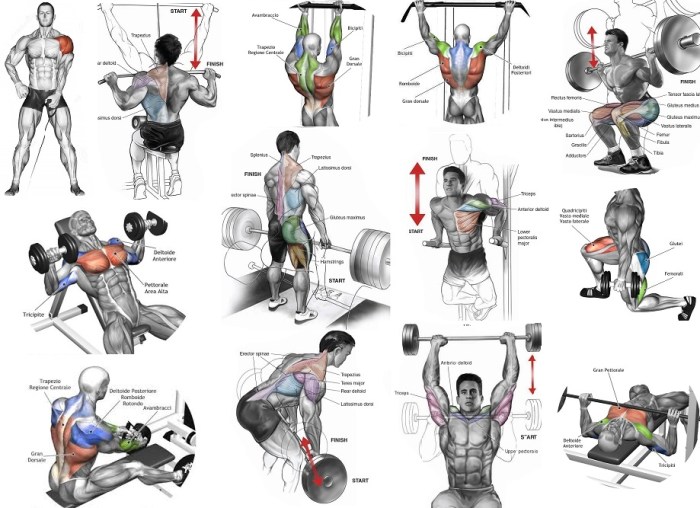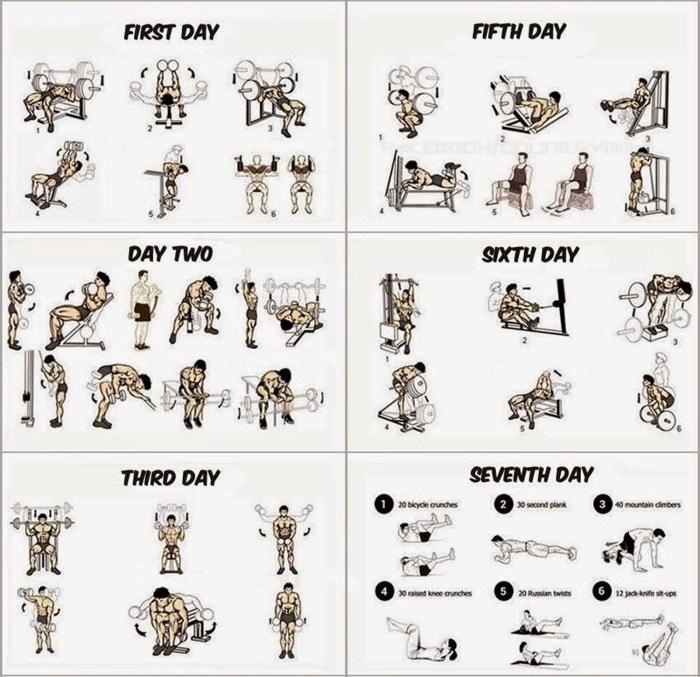Embark on a journey to build strength with a comprehensive strength building routine. Discover the importance of strength training, its benefits for overall health and well-being, and a range of exercises that target different muscle groups. Dive into the fundamentals of a strength training plan, including frequency, intensity, duration, and recovery.
Learn about the crucial role of nutrition in supporting strength building, including recommendations on foods to include in your diet and the importance of hydration and supplementation. Emphasize the significance of proper form and technique to prevent injuries, and provide guidance on warm-ups and cool-downs.
Introduction

Embarking on a strength building routine is a journey towards physical empowerment and overall well-being. Strength training, a cornerstone of fitness, transcends the pursuit of aesthetics and delves into the realm of improved health and longevity.
By engaging in strength building exercises, you unlock a myriad of benefits, including enhanced bone density, reduced risk of chronic diseases, improved mobility, and a boost in self-confidence. These exercises not only target specific muscle groups, but also challenge your body’s core, promoting stability and balance.
Specific Examples of Strength Building Exercises
- Squats:Engage the legs, glutes, and core, building lower body strength.
- Push-ups:Strengthen the chest, shoulders, and triceps, improving upper body power.
- Deadlifts:Work the back, legs, and hips, promoting overall strength and posture.
Key Principles of Strength Training

Strength training involves applying controlled stress to your muscles to make them stronger. Understanding the key principles of strength training can help you maximize your results and minimize the risk of injury.
The three key principles of strength training are:
- Progressive overload
- Specificity
- Recovery
Progressive Overload
Progressive overload means gradually increasing the weight, resistance, or repetitions of your exercises over time. This forces your muscles to adapt and grow stronger.
There are different ways to achieve progressive overload, such as:
- Increasing the weight you lift
- Increasing the number of repetitions you do
- Increasing the number of sets you do
- Reducing the rest time between sets
Specificity
The principle of specificity states that your training should be specific to the goals you want to achieve. For example, if you want to improve your bench press, you should do exercises that target the muscles used in the bench press, such as the barbell bench press and dumbbell flyes.
Recovery
Recovery is essential for strength training. When you strength train, you damage your muscle fibers. Recovery gives your body time to repair these fibers and make them stronger.
There are several ways to promote recovery, such as:
- Getting enough sleep
- Eating a healthy diet
- Staying hydrated
- Taking rest days
Exercises for Strength Building: Strength Building Routine

Strength building exercises are essential for developing muscular strength and overall fitness. These exercises target specific muscle groups and promote muscle growth and strength development.
Effective strength building exercises can be divided into compound and isolation exercises. Compound exercises involve multiple muscle groups in a single movement, while isolation exercises focus on a specific muscle group.
Chest Exercises
- Bench press
- Incline dumbbell press
- Push-ups
- Chest flyes
Back Exercises, Strength building routine
- Barbell row
- Pull-ups
- Lat pulldown
- Seated cable row
Leg Exercises
- Barbell squat
- Leg press
- Hamstring curl
- Calf raises
Shoulder Exercises
- Overhead press
- Lateral raise
- Front raise
- Reverse flye
Sample Strength Building Routine
Strength building routines involve exercises that challenge your muscles to improve their strength and power. This routine is designed to provide a balanced workout for your major muscle groups, promoting overall strength development.
Exercise Selection and Workout Structure
The exercises in this routine are chosen for their effectiveness in targeting different muscle groups. They include compound exercises that engage multiple muscle groups simultaneously, as well as isolation exercises that focus on specific muscles. The workout structure alternates between upper and lower body exercises, allowing for adequate recovery between sets.
Exercise Table
| Exercise | Sets | Reps | Rest ||—|—|—|—|| Barbell Back Squat | 3 | 8-12 | 2-3 min || Bench Press | 3 | 8-12 | 2-3 min || Overhead Press | 3 | 8-12 | 2-3 min || Dumbbell Row | 3 | 10-15 | 2-3 min || Leg Press | 3 | 8-12 | 2-3 min || Hamstring Curl | 3 | 10-15 | 2-3 min || Calf Raise | 3 | 15-20 | 2-3 min |
Exercise Form
Barbell Back Squat:Stand with your feet shoulder-width apart, toes slightly pointed outward. Hold the barbell on your upper back, resting it on your trapezius muscles. Squat down by bending your knees and hips, keeping your back straight and your chest up. Lower until your thighs are parallel to the floor.
Return to the starting position by extending your knees and hips. Bench Press:Lie on a bench with your feet flat on the floor. Grip the barbell slightly wider than shoulder-width apart and lower it to your chest. Press the barbell back up to the starting position, extending your elbows fully.
Overhead Press:Stand with your feet shoulder-width apart, holding a barbell in front of your shoulders, palms facing forward. Press the barbell overhead until your arms are fully extended. Lower the barbell back to your shoulders. Dumbbell Row:Hold a dumbbell in each hand, palms facing each other.
Bend forward at the hips, keeping your back straight. Row the dumbbells up to your chest, squeezing your shoulder blades together. Lower the dumbbells back to the starting position. Leg Press:Sit in the leg press machine with your feet shoulder-width apart.
Push the platform away from you by extending your legs. Lower the platform back to the starting position, bending your knees. Hamstring Curl:Lie on a hamstring curl machine with your heels hooked under the pads. Curl your legs up towards your buttocks, bending your knees.
Lower your legs back to the starting position. Calf Raise:Stand on a calf raise machine with your feet shoulder-width apart. Raise up onto your toes, then lower back down.
“Strength training is essential for overall health and well-being. It not only improves muscle strength but also increases bone density, reduces the risk of injury, and improves metabolism.”
American College of Sports Medicine
Explain how to design a strength building routine that incorporates progression and periodization.
Designing a strength building routine that incorporates progression and periodization is essential for maximizing gains and minimizing the risk of injury. Progression refers to gradually increasing the weight, sets, reps, or intensity of your workouts over time to continually challenge your muscles and promote growth.
Periodization involves dividing your training into specific phases, each with a different focus, such as strength building, hypertrophy, or recovery.
Progression
- Start with a weight that is challenging but allows you to maintain good form for 8-12 repetitions.
- Once you can comfortably perform 12 repetitions with good form, increase the weight by 5-10%.
- Continue increasing the weight as you get stronger, but always prioritize maintaining good form.
Periodization
There are many different periodization models, but a common approach is to divide your training into three phases:
- Accumulation phase:This phase focuses on building a base of strength and muscular endurance. Workouts are typically higher in volume and lower in intensity.
- Intensification phase:This phase focuses on increasing strength and power. Workouts are typically lower in volume and higher in intensity.
- Realization phase:This phase is a short period of time where you test your strength gains with a heavy lift or competition.
After the realization phase, you can start the cycle over again, making adjustments to your progression and periodization based on your progress.
Provide guidelines for nutrition to support strength building, including meal timing and supplementation strategies.
Nutrition plays a crucial role in supporting strength building by providing the necessary energy and nutrients for muscle growth and recovery. Meal timing and supplementation strategies can further optimize the benefits of your training.
Meal Timing
Eating regular meals throughout the day helps maintain stable blood sugar levels and provides a consistent supply of nutrients to your muscles. Aim to eat 3-4 main meals and 1-2 snacks each day, spaced evenly throughout the day.
Supplementation Strategies
Supplements can provide additional nutrients that may enhance strength building. Some common supplements include:
- Protein powder:Convenient way to increase protein intake, especially after workouts.
- Creatine:Helps increase muscle strength and power.
- BCAAs (branched-chain amino acids):Essential amino acids that promote muscle growth and recovery.
Macronutrient Recommendations
Strength building requires adequate intake of protein, carbohydrates, and fats. Here are specific recommendations:
| Nutrient | Sources | Recommended Daily Intake |
|---|---|---|
| Protein | Meat, poultry, fish, eggs, dairy, beans, lentils | 1.6-2.2 grams per kilogram of body weight |
| Carbohydrates | Whole grains, fruits, vegetables | 6-10 grams per kilogram of body weight |
| Fat | Healthy oils (olive oil, avocado oil), nuts, seeds | 20-35% of total calories |
Special Considerations

Strength building routines should be tailored to individual needs and abilities. Here are some special considerations for different populations:
Beginners
- Start with a light weight and gradually increase it as you get stronger.
- Focus on proper form to avoid injuries.
- Listen to your body and rest when needed.
- Find a workout buddy or trainer for support and motivation.
Older Adults
- Choose exercises that are low-impact and joint-friendly.
- Start with a lighter weight and gradually increase it as tolerated.
- Pay attention to your balance and stability.
- Consult with a healthcare professional before starting any new exercise program.
Individuals with Injuries
- Work with a physical therapist to design a safe and effective routine.
- Focus on exercises that do not aggravate the injury.
- Use proper form and avoid overexertion.
- Listen to your body and rest when needed.
Mindset and Motivation
Building strength requires not only physical effort but also a strong mindset and unwavering motivation. Cultivating the right mindset can help you overcome challenges, stay focused, and achieve your strength-building goals.
Here are key principles of mindset and motivation for strength building:
| Principle | Description |
|---|---|
| Goal Setting | Establish specific, measurable, achievable, relevant, and time-bound (SMART) goals to provide direction and focus. |
| Self-Belief | Believe in your ability to achieve your goals. Visualize success and focus on your strengths. |
| Positive Self-Talk | Replace negative thoughts with positive affirmations. Encourage yourself and celebrate your progress. |
| Managing Setbacks | View setbacks as opportunities for learning and growth. Stay positive, analyze your mistakes, and make adjustments. |
| Training Partner or Coach | Find a supportive training partner or coach for accountability, motivation, and guidance. |
Last Recap
By incorporating these principles and exercises into your routine, you can effectively build strength, improve overall fitness, and enhance your well-being. Remember to approach strength building with patience, consistency, and a commitment to progress.
Answers to Common Questions
What are the benefits of strength building?
Strength building can enhance overall health and well-being by increasing muscle mass, improving bone density, reducing the risk of chronic diseases, and boosting metabolism.
How often should I perform strength training exercises?
For beginners, aim for 2-3 strength training sessions per week. As you progress, you can gradually increase the frequency and intensity of your workouts.
What is the importance of proper form in strength training?
Proper form ensures that you are targeting the correct muscles, maximizing the effectiveness of the exercise, and minimizing the risk of injuries.
Leave a Reply